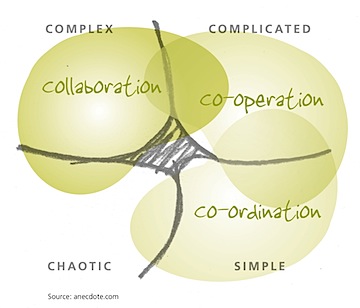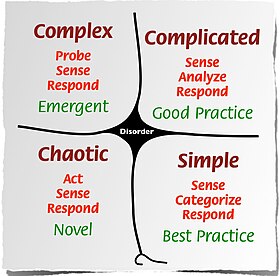 "Cynefin" Welsh for "Habitat" of "home", is a framework that in my opinion is like no other can typify and communicate situations. The beauty of the framework is that it is not a glorification of nor aversion to a specific methodology. The framework doesn't describe the ideal organization. And, the framework can handly the dynamics of the situation.
"Cynefin" Welsh for "Habitat" of "home", is a framework that in my opinion is like no other can typify and communicate situations. The beauty of the framework is that it is not a glorification of nor aversion to a specific methodology. The framework doesn't describe the ideal organization. And, the framework can handly the dynamics of the situation.I've been educated with all sorts of business models and theories. It has been a long time that I saw something like this: this is a beautiful framework!
Around 2007 the Cynefin framework was invented by Dave Snowden working for IBM. Now Dave is part of Cognitive-Edge. A book is in the making, but fortunately in addition to trainings there are blogs, podcasts and videos. Not all of them are that accessible for Dave likes, in my opinion, difficult words. Most likely these difficult words are pretty precise to communicate his message. However, they case a bit of a threshold as well in my opinion. Besides this, Dave likes to make certain things very clear, for instance he referst to 6 Sigma as Sick Stigma. He has some strong arguments to make his case. By the way, related to 6 Sigma and nothing to do with Cynefin nor Dave Snowden, this article is an interesting one to read/look at "Six Sigma 'killed' innovation in 3M".
In this blog I will only address the Cynefin framework. I won't address the other very interesting solutions that Cognitive Edge has to offer (SenseMaker, methods based on complexit thinking. I'll make an effort to make the step towards the Cynefin a bit more accessible: simple English and how it can be used. But let's start with what Cynefin is not.
What Cynefin framework is not
It is not a glorification of a certain methodology or world view. However this was my first impression. Probably caused by the fragmented pieces, the strong and very recognizable comments of Dave on 6 Sigma and his enthousiasm for complexity thingking.
Nowadays it is pretty cool to talk about growth and maturity models. All these models are full of ideal types and oh boy, if you do not make progression you are in for some trouble. The Cynefin is none of this, it is not a growth or maturity model.
According to Gartner around 2016 10% of all IT departments will use Cynefin. However, Cynefin has as much to do with IT as with Purchasing, Sales, Strategy. Cynefin is not restricted to IT.
What is the Cynefin framework
Metaphorically speaking I think the Cynefin framework is a model to ascertain you're dealing with a nail or a screw. With the meta-approach of Cynefin it helps to decide if it is better to use a hammer or a screwdriver. That is one side of it.
On the other side, the Cynefin framework is very good in dealing with dynamics, changing situations. What to do if you have fifty nails and three screws? Or what if you have nails, but they are not good for the job, how to make (more) certain you get your screws?
Typifying a situation with the Cynefin framework
What follows is how I now would use Cynefin with people who never heard about Cynefin. Preferably with a flip-over and some post-its. The procedure below is actually based on one of Cognitive Edge's techniques.
- Observe the situation and describe it in statements on a post-it.
- Is there only one possible action/solution that nobody even thought about disputing it? Then you're dealing with the Simple Domain.
- Are possible actions/solutions possible where an expert can provide a substantiated choice that all stakeholders will accept? Then you're dealing with the Complicated Domain.
- Are more actions/solutions possible but the answer of the expert, how well substantiated, will not be followed? Then you're dealing with the Complex Domain.
- If it is not known what is going on, but action must be taken now, then you're dealing with the Chaotic Domain.
- If none of the above seems to be applicable then you're in the Disorder Domain.
- Of course it is possible to break the situation into pieces. Rarely a complete situation will reside fully in one domain (30 nails, 10 screws ...always convienant that you don't have to use either the hamer or the screwdriver)
I like to add to the above picture the term 'constraints'. In the Simple Domain there is (almost) zero room for deviation, this domain is heavily constrained. In the Complicated Domain there is a bit of room, but constrains pretty much determine the game. Both the Simple and Complicated Domain are pretty predictable. It is the domain of system thinking.
In the Complex Domain, the constraints are much looser. People, ideas, resources are ineracting in an interactive way. The results are usually easy to explain in hindsight. However, predicting the results is one of guessing. Too many small things can each have a big impact.
In the Chaotic Domain the constraints are not known. Key is to find some form of control by the introduction of one or more constraints.
In the Complex Domain, the constraints are much looser. People, ideas, resources are ineracting in an interactive way. The results are usually easy to explain in hindsight. However, predicting the results is one of guessing. Too many small things can each have a big impact.
In the Chaotic Domain the constraints are not known. Key is to find some form of control by the introduction of one or more constraints.
What next
After typifying you can see which tool is more conveniant: the hammer, screwdriver, etc. I will limit myself by giving two project related examples:
Complex --> Complicated
A large project with many players and stakeholders is not going anywhere. Several (external) experts have in vain tried to get things going with their expertise and knowledge. A typical example of a situation that lives in the Complex Domain.
A large project is not managable if it resides in the Complex Domain. A solution that works in a number of cases, is one of going into a process of 'self-constraining' with the involved stakeholders. The situation then is becoming that resides in the Complicated Domain and 'suddenly' all the standard project management things work.
A large project is not managable if it resides in the Complex Domain. A solution that works in a number of cases, is one of going into a process of 'self-constraining' with the involved stakeholders. The situation then is becoming that resides in the Complicated Domain and 'suddenly' all the standard project management things work.
Complicated --> Complex
The opposite happens as well. A well organized project that ran well gets stuck. People keep reminding each other: agreed is agreed. Experts try to find solutions, but the project is just stuck in that area. Because of the tight constraints (agreed is agreed), the project resides in the Complicated Domain. However, by loosing up the 'constraints' a number of agreements and solutions can be given a bit more space and room for exploring and finding alternatives. That part of the project will move then to the Complex Domain. Important is that all relevant stakeholders will be involved and come up with a new agree solution. And this can be 'brought' into the Complicated domain again.
These are just but a few examples from my own experience.
Summery
I am truly impressed by the Cynefin framework. It gives me a better insight why some things work and don't work. It gives me a way to discuss seemingly difficult situations in a simple way. I have been brouhgt up with all kinds of organizational models and theories. It has been a long time since I said: this is very beautiful!

No comments:
Post a Comment